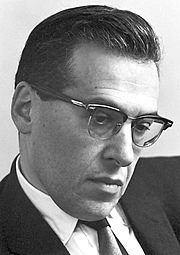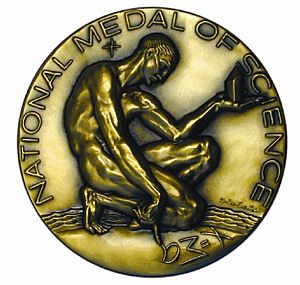Julian Schwinger facts for kids
Quick facts for kids
Julian Schwinger
|
|
|---|---|
 |
|
| Born |
Julian Seymour Schwinger
February 12, 1918 |
| Died | July 16, 1994 (aged 76) Los Angeles, California, USA
|
| Nationality | United States |
| Awards | Albert Einstein Award (1951) National Medal of Science (1964) Nobel Prize in Physics (1965) |
| Scientific career | |
| Fields | Physics |
Julian Seymour Schwinger (born February 12, 1918 – died July 16, 1994) was an American theoretical physicist. He won a Nobel Prize for his important work. Schwinger is best known for helping create the theory of quantum electrodynamics (QED). This theory explains how light and matter interact. He was a physics professor at many universities. Many people see Schwinger as one of the greatest physicists of the 1900s. He helped shape much of modern quantum field theory.
Contents
About Julian Schwinger
Julian Seymour Schwinger was born in New York City. His parents were from a Jewish background. He went to Townsend Harris High School. Then he studied at the City College of New York. Later, he moved to Columbia University. He earned his first degree there in 1936. By 1939, at just 21 years old, he had his Ph.D.
After university, Schwinger worked at the University of California, Berkeley. He worked with a famous scientist named J. Robert Oppenheimer. Later, he got a job at Purdue University in 1941.
Work During World War II
During World War II, Schwinger took a break from Purdue. He worked at the Radiation Laboratory at MIT. He did not work on the atomic bomb project. Instead, he helped develop radar. Radar was very important for finding planes and ships. He provided scientific support for this new technology.
Teaching at Harvard
After the war, Schwinger left Purdue. He went to Harvard University in 1945. He taught there until 1974. In 1966, he became a special professor of physics at Harvard. Schwinger was known for being an amazing teacher. Many of his students went on to become famous scientists. Four of his students even won Nobel Prizes. These students were Roy Glauber, Benjamin Roy Mottelson, Sheldon Glashow, and Walter Kohn. Walter Kohn won his Nobel Prize in chemistry.
Awards and Honors
Schwinger received the Nobel Prize in Physics in 1965. He shared the prize for his work on quantum electrodynamics (QED). This was a huge honor. But he had won many awards even before the Nobel Prize.
His awards included the first Albert Einstein Award in 1951. He also received the U.S. National Medal of Science in 1964. He got honorary science degrees from Purdue University in 1961 and Harvard University in 1962. In 1949, he won the Nature of Light Award. This award came from the U.S. National Academy of Sciences.
Later Life and Legacy
Julian Schwinger passed away on July 16, 1994. He died from pancreatic cancer. He is buried at Mount Auburn Cemetery. On his tombstone, there are special symbols. These symbols represent his important calculation. It was about a tiny correction to the magnetic moment of the electron. This showed how precise his work was in physics.
Images for kids
-
Julian Schwinger, winner of the 1965 Nobel Prize in Physics.
See also
 In Spanish: Julian Schwinger para niños
In Spanish: Julian Schwinger para niños




